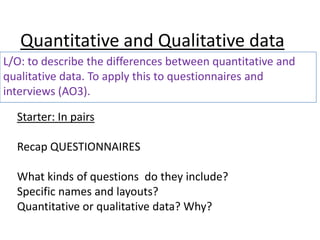
Quantitative and qualitative data, questionnaires, interviews
- 1. Quantitative and Qualitative data L/O: to describe the differences between quantitative and qualitative data. To apply this to questionnaires and interviews (AO3). Starter: In pairs Recap QUESTIONNAIRES What kinds of questions do they include? Specific names and layouts? Quantitative or qualitative data? Why?
- 2. L/O: to describe the differences between quantitative and qualitative data (AO3). Quantitative research What are the likely features of quantitative research then? • Gathering numerical data – numbers • The researcher assigns numerical values. • Always involves measuring in some way e.g. ‘how many times…’ • Analysis: Statistically analysed for numerical patterns / relationships. • Objective = limited opinion and interpretation.
- 3. L/O: to describe the differences between quantitative and qualitative data (AO3). Qualitative research …and for qualitative research? • Gathers non-numerical information – words. • Focuses on experiences and feelings. • Open ended questions e.g. ‘What is your experience of…’ • Analysis: usually summarised. • Subjective = lots of opinion and interpretation.
- 4. L/O: to describe the differences between quantitative and qualitative data (AO3). Why choose one over the other? Aims and purpose of the research? Create an aim for research that would require gathering: a. Quantitative data b. Qualitative data c. Both quantitative and qualitative data.
- 5. L/O: to describe the differences between quantitative and qualitative data (AO3). Can we? Quantitative Qualitative • To do with QUALITY. • Very controlled. • Focus on collecting opinions. • Is less controlled. • To do with QUANTITY. • Analysis can be subjective (lots of interpretation). • Focus on collecting numbers. • Analysis can be objective (limited interpretation).
- 6. To apply this to questionnaires and interviews (AO3). Questionnaires: self-report technique Types of questions Type 1: Closed questions - Rank order questions - Likert scale questions Generate - Checklist questions QUANTITATIVE data - Dichotomous questions - Semantic differential questions. Generate Type 2: Open questions. QUALITATIVE data
- 7. To apply this to questionnaires and interviews (AO3). Interviews: self-report technique Structured interview: A.K.A. ‘verbal questionnaire’. Verbal response to a set of set questions. Semi-structured interview: no fixed questions but a guided interview with a set of predetermined topics. The way questions are asked can vary. Unstructured interview: just a topic set and the participant talks about anything they like.
- 8. To apply this to questionnaires and interviews (AO3). Interviews: self-report technique Structured interview: Generates Semi-structured interview: quantitative or qualitative Unstructured interview: data? How? Reliability? Validity? Bias? Ethical Issues?